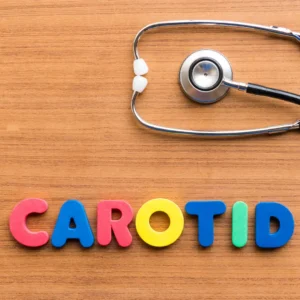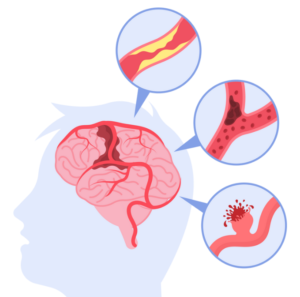Cerebrovascular Disease
CAROTID BODY TUMORS
Carotid Body Tumors : What You Need to Know
A carotid body tumor (CBT) is a rare, slow-growing lump that develops near the carotid artery in your neck. The carotid body is a small organ that helps detect oxygen levels in your blood. Most of these tumors are not cancerous, but in rare cases, they can spread.
Who Gets It?
Carotid body tumors are uncommon and mostly affect adults, usually around middle age with the peak age group being between 50 and 70 years old.
Why Does It Happen?
The carotid body responds to changes in oxygen levels, and sometimes, its cells grow abnormally, forming a tumor. In some people, genetic factors may play a role in its development.
Signs and Symptoms
Most people notice a painless lump on the side of their neck, just below the jaw. Other possible symptoms include:
- A change in voice or hoarseness
- Trouble swallowing
- Numbness in tongue
- Sore throat
How is it Diagnosed?
Doctors use different tests to confirm a carotid body tumor:
- Ultrasound with Doppler – A simple scan to check blood flow.
- CT or MRI Scan – Creates detailed images of the tumor.
- Angiography – A special X-ray to examine blood vessels before surgery.
- Genetic Testing – Recommended if others in your family have had similar tumors.
Treatment Options
The best treatment depends on the size and location of the tumor. Options include:
- Yearly surveillance scan (If borderline)
- Endarterectomy
- Stenting
- Bypass
Final Thoughts
Carotid body tumors are rare but usually not life-threatening. If you notice a lump in your neck or have other symptoms, it’s important to see a doctor early. Early diagnosis and proper treatment can lead to good outcomes. If you have a family history of these tumors, genetic counseling may help assess your risk.
TRANSIENT ISCHEMIC ATTACK
Transient Ischemic Attack: A Patient's Comprehensive Guide
A Transient Ischemic Attack (TIA) often referred to as a “mini-stroke,” happens when the blood flow to the brain is briefly blocked. Unlike a regular stroke, a TIA does not cause permanent damage, but it is a serious warning sign of potential future strokes.
Causes of TIA
A TIA occurs when there is a temporary disruption in blood flow to the brain, which can be caused by:
- Blood clots : Small clots that temporarily blocks a brain artery.
- Narrow Arteries (Atherosclerosis) : Narrowing of blood vessels due to plaque buildup.
- Embolism : Blood clots traveling from the heart or other arteries to the brain.
- High blood pressure (Hypertension) : Increases the risk of vessel blockage.
- Heart disease : Conditions such as atrial fibrillation increase clot formation.
Symptoms of TIA
TIA symptoms are similar to a stroke but it resolves within minutes or hours. Common symptoms include:
- Sudden weakness or numbness on one side of the body.
- Difficulty speaking or understanding speech.
- Blurred or double vision.
- Dizziness, loss of balance, or coordination.
- Sudden or severe headache with no known cause.
Diagnosis
Diagnosing a TIA involves a combination of clinical assessment and imaging tests:
- Physical and neurological examination : Evaluating reflexes, strength, and coordination.
- Imaging tests :
- MRI or CT scan : Detects brain abnormalities.
- Carotid ultrasound : Examines blood flow in carotid arteries.
- Echocardiogram : Checks for heart-related sources of blood clots
- Blood tests : Assess cholesterol, blood sugar, and clotting function.
Treatment and Prevention
TIA is a warning sign of a possible stroke, hence immediate intervention is necessary. Treatment on reducing stroke risk includes:
Medications
- Blood thinners : Aspirin or clopidogrel to prevent clot formation.
- Blood pressure control : Helps keep blood pressure in a healthy range.
- Cholesterol-lowering drugs : Reduces fatty deposits in arteries.
Lifestyle Modifications
- Healthy eating : More fruits, vegetables and whole grains. Less saturated fats, salt, and cholesterol.
- Regular exercise : At least 30 minutes of moderate activity daily.
- No smoking : Smoking increases the risk of stroke.
- Limiting alcohol : Drinking too much can raise blood pressure.
- Managing diabetes : Keeping blood sugar levels within a healthy range.
Surgical Interventions
- Carotid endarterectomy : Removes blocked arteries.
- Angioplasty and stenting : Opens / widens narrowed arteries.
Conclusion
A Transient Ischemic Attack (TIA) is a critical warning sign of an impending stroke that should not be ignored. By recognizing the warning signs early and making necessary lifestyle adjustments, individuals can take control of their health and significantly reduce the chances of future complications.


